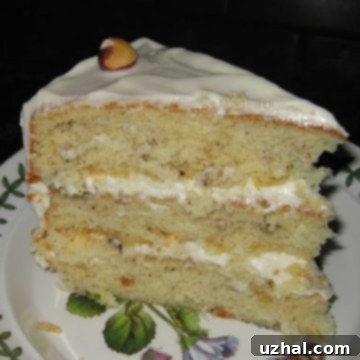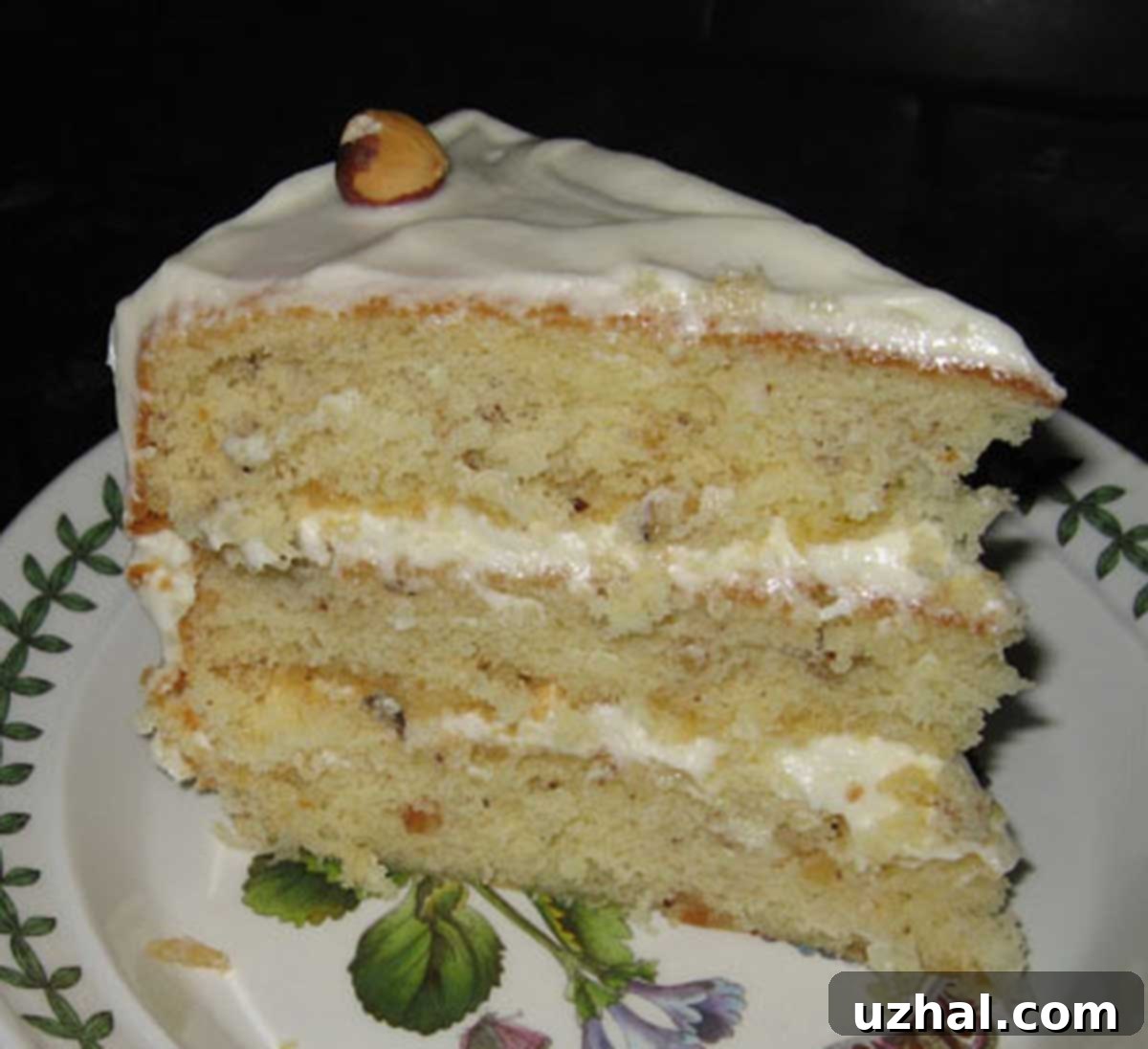Decadent Hazelnut Cream Cake: A Southern-Inspired Delight
Prepare to be enchanted by our Hazelnut Cream Cake, a delightful and sophisticated twist on the beloved Southern classic, Italian Cream Cake. While the traditional version often features pecans, our recipe elevates this rich, moist dessert by infusing it with the warm, earthy notes of toasted hazelnuts. It’s a cake that boasts layers of tender crumb, generously adorned with a luscious cream cheese frosting, promising a truly irresistible experience for any dessert lover.
Unraveling the Mystery: The Southern Roots of “Italian” Cream Cake
Despite its intriguing name, “Italian Cream Cake” is not a culinary export from Italy. Instead, it is a quintessential American dessert, deeply rooted in the rich baking traditions of the Southern United States. This creamy, buttery cake, often highlighted by coconut and pecans, and always crowned with a tangy cream cheese frosting, is a hallmark of Southern hospitality and celebration. The widespread use of pecans, a nut native to North America, further solidifies its Southern American identity. Our Hazelnut Cream Cake respects this heritage while introducing a fresh, European-inspired flavor profile that complements the cake’s characteristic richness beautifully.
The Genesis of This Hazelnut Masterpiece
Our specific Hazelnut Cream Cake recipe hails from a cherished culinary compilation, “Food Editors’ Hometown Favorites.” This collection, known for its reliable and beloved recipes, features this particular gem as submitted by Barbara Durbin of The Oregonian, who graciously credits Linda Dau Gray-Fellows of Hillsboro for its original inspiration. Such a well-documented lineage speaks to a recipe that has been tested and approved by discerning palates, guaranteeing a successful and delicious outcome for your home baking.
My own experience with baking this cake has been nothing short of delightful. The moist crumb and the aromatic scent of hazelnuts create an extraordinary dessert. Initially, I wondered if the recipe called for enough frosting; I even considered increasing the quantity by about a third to achieve a thicker layer. However, with the perspective of a more seasoned baker, I’ve come to appreciate that the specified amount of frosting is perfectly adequate for this cake. It provides a balanced ratio of frosting to cake, allowing the subtle hazelnut flavor and tender texture to truly shine. Of course, if you are a maximalist when it comes to frosting or plan on elaborate decorations, you might still consider a slight increase. But for a classic presentation and ideal flavor harmony, the recipe’s measurements are spot on.
Why Hazelnuts are the Perfect Substitute
The decision to swap traditional pecans for hazelnuts in this cream cake is a stroke of culinary genius. Hazelnuts bring a distinct sweetness, a buttery richness, and a subtle earthy undertone that transforms the cake into something truly special. When lightly toasted, their flavor intensifies, adding a delightful crunch and an even deeper aromatic complexity. This choice lends the cake a gourmet touch, making it ideal for special occasions or simply elevating an everyday dessert to an extraordinary treat. The unique flavor pairing with coconut and the tangy cream cheese frosting creates a harmonious symphony of tastes and textures that is sure to impress.
The Magic of Buttermilk in Baking
Buttermilk is a key ingredient that contributes significantly to the signature texture and flavor of this Southern-style cake. Its natural acidity reacts with the baking soda, resulting in a wonderfully light, tender, and moist crumb. This chemical reaction not only provides lift but also adds a subtle tang that balances the sweetness of the cake. If you don’t have buttermilk readily available, you can easily make a substitute at home: simply add one tablespoon of lemon juice or white vinegar to a liquid measuring cup, then fill it up to the one-cup mark with regular milk. Let it sit for 5-10 minutes until it slightly curdles, and you’ll have a perfect buttermilk substitute ready for your recipe.
Recipe

Hazelnut Cream Cake
Cookie Madness
Pin Recipe
Ingredients
- 2 cups sifted flour (250 grams)
- 1 tsp. baking soda
- ½ teaspoon salt use ¼ if using salted butter
- 5 large eggs separated
- ½ cup unsalted butter, room temperature (114 grams)
- ½ cup regular or butter flavored shortening (96 grams)
- 2 cups granulated sugar (400 grams)
- 1 tsp. vanilla extract
- 1 cup buttermilk
- ⅓ cup coconut more if desired
- 1 c. finely chopped toasted hazelnuts
Cream Cheese Frosting (You May Want to Increase)
- 8 oz cream cheese, softened (230 grams)
- 4 oz butter, room temperature or softened (114 grams)
- 3 ½ cups of powdered sugar (300-400 grams)
- 1 teaspoon vanilla extract
- Whole milk as needed
Instructions
-
Preheat your oven to 350°F (175°C). Prepare three 9-inch round cake pans by generously spraying them with a flour-added cooking spray or by greasing and flouring them thoroughly. This ensures your cakes release easily. If you are using dark cake pans, reduce the oven temperature slightly to 325°F (160°C) to prevent the bottoms and edges from over-browning.
-
In a medium bowl, take the already-sifted flour and sift it once more with the baking soda. This extra sifting step is important for achieving an even lighter, airier cake texture and helps to thoroughly distribute the leavening agent. If you don’t have a sifter, you can achieve a similar effect by whisking the flour and baking soda together very vigorously for at least 30 seconds. Finally, stir in the salt to this dry mixture and set it aside.
-
Using a separate, clean mixing bowl, beat the egg whites until they form stiff peaks. This means when you lift the beaters, the egg whites should stand straight up and hold their shape. Be careful not to overbeat, as this can make them dry and brittle. Once stiff, gently set these beaten egg whites aside; they will be folded into the batter later to provide lightness and structure.
-
In a large mixing bowl, cream together the softened unsalted butter and shortening until the mixture is light and fluffy. This step is crucial for incorporating air, which contributes to the cake’s tender texture. Gradually add the granulated sugar, continuing to beat for 3-5 minutes until the mixture becomes pale in color and noticeably airy. Next, beat in the vanilla extract. Then, add the egg yolks one at a time, ensuring that each yolk is fully incorporated and the mixture is smooth before adding the next. This careful addition creates a stable emulsion, contributing to the richness of the cake.
-
Reduce your mixer speed to low, or for best results and to prevent overmixing, switch to a mixing spoon or a heavy-duty rubber scraper for this stage. Add the flour mixture and buttermilk alternately to the creamed butter mixture, making sure to begin and end with the flour. For instance, add about a third of the flour mixture, mix briefly until just combined, then add half of the buttermilk, mix, followed by another third of the flour, the remaining buttermilk, and finally the last third of the flour. Mix only until the batter is uniform and no streaks of dry flour remain. Overmixing at this stage can develop gluten, leading to a tough cake. Gently fold in the stiffly beaten egg whites in three separate additions; this technique helps to maintain the airy texture of the batter. Lastly, carefully stir in the coconut and the finely chopped toasted hazelnuts until they are evenly distributed throughout the batter.
-
Divide the prepared cake batter evenly among your three 9-inch round cake pans. Place the pans in the preheated oven and bake for approximately 25 minutes, or until a wooden skewer or toothpick inserted into the center of each cake comes out clean. It’s normal for these cakes to appear somewhat flatter than other types of cakes. Once baked, remove the cakes from the oven and allow them to cool in their pans on a wire rack for about 10-15 minutes before carefully inverting them onto the wire racks to cool completely. It is crucial that the cakes are entirely cool before you proceed with frosting them to prevent the frosting from melting.
-
While your cake layers are cooling, prepare the rich and creamy cream cheese frosting. In a large mixing bowl, combine the softened cream cheese and room-temperature butter. Beat these two ingredients together until the mixture is completely smooth and lump-free. Gradually add about half of the powdered sugar, beating until it is well combined. Slowly incorporate the remaining powdered sugar, continuing to beat until the frosting is light, fluffy, and beautifully creamy. Stir in the vanilla extract. If the frosting seems too stiff or thick, add whole milk one teaspoon at a time, beating after each addition, until it reaches your desired creamy, spreadable consistency. Once your cakes are thoroughly cooled, spread this delicious frosting generously between each cake layer and then over the top and sides of the entire cake for a truly decadent and complete dessert.
